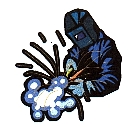wolverine_arc wrote: (...) Any tips, tricks, video links and advice on how to do flat (
not to convex nor concave) weld beads in GMAW. (...)

=====
Wolverine.
What type of joints are you welding (wall thickness, bevels)?
Often a flat cover pass with depend upon the planning of your passes, in particular the second to the last layer.
The degree of overlapping your side-by-side stringer passes will also make a difference on flatness.
Instead, if you are weaving, you will need to fill the sides, and adjust your speed across the middle to make it flat.
Needless perhaps to say, if we are simply welding a pass on a flat surfaced piece of metal, then of course, it will never be flat, in that all the deposited metal is excessive. But it is a good practice to see how the torch angle affects flatness. Start dragging, then gradually change the angle of the torch until it is perpendicular to the surface, and then gradually descend to pushing. You should see a different in pass appearance.
Alexa




